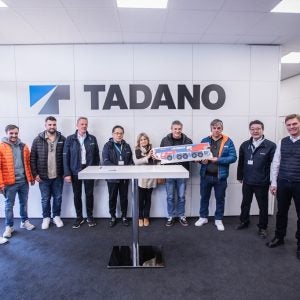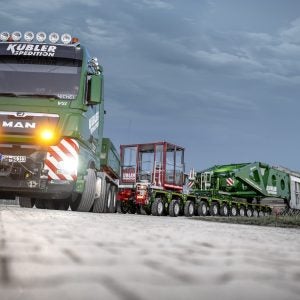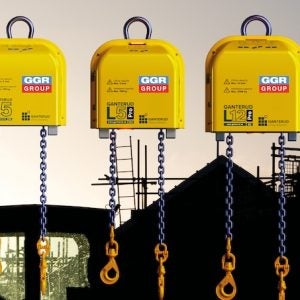The first of the joint ventures, SanyPalfinger SPV Equipment Ltd., will see Palfinger and Sany form a partnership to build up to 10,000 cranes a year in Changsha, close to Sany’s existing plant. Palfinger CEO Herbert Ortner, describing the announcement as Palfinger’s biggest news since its IPO in 1999, told Cranes Today, “We will be building a brand new factory. We’re looking for a market leadership position in China. As it comes to truck sales and market conditions, we expect fantastic growth. We wlll produce, assemble, and mount cranes as a first step. Later we’ll move to building tailifts and hooklifts.
“We’ll bring in technology, drawings and design, and adapt them to the Chinese market. At the end of the day, we’re planning fully integrated production and assembly. In the next few years, this will be the biggest plant of Palfinger in the world for cranes.
“The joint venture contract was signed yesterday. Next we need a business license. We are approaching the Chinese officials for this. We expect that will take four to six months. In the second half 2012, we can incorporate the company, then ramp up factory. We should be at full capacity by 2013–2014 for cranes. Once we see potential for hook loaders, platforms, we will go ahead with that.”
Traditionally, loader cranes sales have trailed those of more basic truck mounted cranes in China: Cranes Today estimates that around five 8–25t truck cranes are sold in the country for every one loader crane. However, Ortner believes that mix is changing, and as China’s economy develops, loader cranes will be increasingly important.
Ortner says, “The market for knuckleboom and stiff boom cranes in China in 2011 was 10,000 units: 7,200 stiff boom and a bit less than 3,000 for knucklebooms. At the moment biggest player is XCMG, with 60% of the market. Then there are some smaller local companies and imports. We expect market to grow to around 30,000 units in the next few years. This is standard with development in Europe and the Americas.
“The market will change. Labour costs are increasing. There is a lot of pressure to increase productivity in the logistic chain. The mobility of the labour force is limited by the One Child policy.
“The last five-year plan was focused on big infrastructure and cities. These megacities used a lot of tower cranes. In the next five-year plan, they want to build 32m new private homes: for this you will need Palfinger logistics equipment. This is a normal development in emerging countries as a middle class develops, and wants to move from flats to private homes.
“As a fixed target of the five years plan, this is a trend we can rely on. No-one knows what will happen with private development on top of that. Market may cool down a little, but we are in at the starting point.
“In China, 1.3m new trucks are registered each year, compared to 300,000 each in Europe and US. China is the world’s biggest market for trucks and mobile cranes. There is no reason why our product section will not be needed. Long term, we expect same ratio of trucks to need cranes as in other markets, but this will come step by step. But, you only need to look at number of trucks: as automation and the logistic concept comes, more loading devices will be fitted on trucks
“In Brazil and Russia, penetration of loading devices has got higher and higher. I see no reason why China should go a completely different way.”
The other side of the deal will see Palfinger distribute Sany mobile cranes around the world. As well as being a big boost to Sany’s distribution of its products globally, it will be the first time Palfinger has sold mobile cranes, rather than its traditional range of loaders. Ortner says, “We will be selling their mobile crane product group around the world. They were looking for an overseas distribution network. This will be sales and service network for their mobile cranes.
“They are bringing their products. We have market knowledge in Europe, maybe not like Liebherr or Tadano for mobile cranes, but we know the market, regulations, service requirements. Together we will build up a network. We will have exclusive sales and service for Sany mobile cranes in Europe and Russia; in the Americas, we will have an exclusive agreement on their TCC truck mounted cranes.
“Just like we want to reduce our dependence on Europe, they want to reduce their dependence on China. This move is like their deal to buy Putzmeister and to build a new factory in the USA.
“It’s a big step for us. But, that is why we are market leaders, we’re not afraid of big steps. That’s why we went into Russia, into Brazil.
“It will be a fully independent business unit. We will be recruiting people from the industry with expertise in mobile cranes. It will be a step-by-step process. They also need to adapt their machines to the EU market. We have network of dealers. If they are willing to invest, we will sit with them and Sany to see if they can offer sales and service. We and Sany will invest with them.
“In some cases, we have the same customer base: big rental companies buying truck mounted platforms, and mobile cranes, so the Palfinger name is well recognised. I know this is not everything: we have to invest, bring in people from the industry.”
“We are the world market leader. If we want to remain market leader, we need to be in China. To do that, we need to have a Chinese partner.”
Announcing the deal with Ortner, Liang Wengen, chairman of Sany Heavy Industry, agreed with this analysis: “This close cooperation with Palfinger is a major step towards tapping the global market. We will use Palfinger’s dense, international sales and service network to promote the globalization of Sany from a Chinese perspective.
“We are looking forward to our cooperation with a partner that is a technology and market leader and whose customer proximity and comprehensive services are highly appreciated by its customers. We are fully convinced that these two joint ventures will swiftly achieve success, thereby making a significant contribution to the rapid and sustained growth of Sany.”






